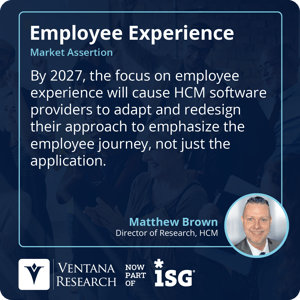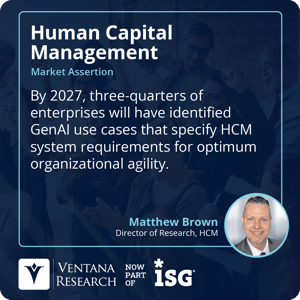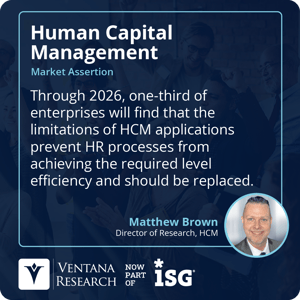The importance of human resources technology in the workplace is growing at a phenomenal pace. While many HR applications like payroll, benefits management and human resource information systems have been perceived as critical, the new sense of criticality is more extensive than ever. HR technology is necessary to power the function of HR, but it also needs to serve as the leading example of how to engage, embrace and include all workers in the workplace experience and community. HR professionals must recognize that there is unrealized ROI in maximizing HR technology for more than its inherent functional value. By 2027, the focus on employee experience will cause HCM software providers to adapt and redesign their approach to emphasize the employee journey, not just the application.
Concepts like “smart” and “sustainable,” relative to HR technology, can be loosely defined as aligning with the needs of the business and providing people with enough flexibility to adjust to future scenarios of business  evolution. While we may never have 100% confidence in future predictions, honest, inclusive conversations about the realities of our businesses can help anticipate scenarios that are often overlooked when establishing or revamping the tech stack. At a minimum, these scenarios should include variations in the 1, 3- and 5-year business outlook on projected revenue and workforce changes. Additionally, we should include what-if scenarios tied to recent workplace disruptions, such as a transient full-time workforce and navigating complex regulatory requirements.
evolution. While we may never have 100% confidence in future predictions, honest, inclusive conversations about the realities of our businesses can help anticipate scenarios that are often overlooked when establishing or revamping the tech stack. At a minimum, these scenarios should include variations in the 1, 3- and 5-year business outlook on projected revenue and workforce changes. Additionally, we should include what-if scenarios tied to recent workplace disruptions, such as a transient full-time workforce and navigating complex regulatory requirements.
Too often, businesses lose sight of the future when going through an HR technology provider evaluation and selection process and get bogged down in the effort to finish the implementation. This leads to systems launched with basic features and lofty aspirations to adopt more features over time. The challenge is that “tomorrow” never comes. Any change in business priority or economic landscape will cause a chain reaction that can prevent the transformation from staying on track with the original intention to enable additional features over time. Many who can identify with this concept also find themselves contemplating the strategy to run out the clock on contracts and opt for a replacement system, further perpetuating the cycle.
The core components of a smart HR tech stack should support all aspects of the life cycle and demands of the employee experience, ensuring alignment with how people get work done. The scope of HR technology has  expanded over the past few years to include applications beyond the standards of recruiting, onboarding, learning, performance, compensation, benefits, payroll and HRIS. It is becoming more commonplace for HR to be the keeper of workforce engagement software that supports health and wellness, diversity, inclusion, equity, belonging, communication, collaboration, coaching, mentoring, rewards and recognition and creative career explorations. Each component supports one or more pillars of the employee journey throughout their tenure with an organization. In addition to these critical elements, integrated people analytics and artificial intelligence enable more effective response to changing conditions and further align the correlations between talent investments and business outcomes. By 2027, three-quarters of enterprises will have identified GenAI use cases that specify HCM system requirements for optimum organizational agility.
expanded over the past few years to include applications beyond the standards of recruiting, onboarding, learning, performance, compensation, benefits, payroll and HRIS. It is becoming more commonplace for HR to be the keeper of workforce engagement software that supports health and wellness, diversity, inclusion, equity, belonging, communication, collaboration, coaching, mentoring, rewards and recognition and creative career explorations. Each component supports one or more pillars of the employee journey throughout their tenure with an organization. In addition to these critical elements, integrated people analytics and artificial intelligence enable more effective response to changing conditions and further align the correlations between talent investments and business outcomes. By 2027, three-quarters of enterprises will have identified GenAI use cases that specify HCM system requirements for optimum organizational agility.
The employee experience should be consistent at all touchpoints to maximize retention, engagement and productivity. The HR tech stack can deliver consistent levels of service and support while also enabling a more personalized experience. System integration has always been a sore spot for HR, making it necessary to prepare a thoughtful and documented systems strategy that includes impacts, touchpoints, integrations and outcomes.
When talent-related data is consumed in isolation, it often leads to an incomplete conclusion, resulting in misguided efforts to solve the wrong challenge. When talent data is integrated with other business data, real transformation can take place. Imagine an experience where an applicant’s skills are inventoried and assessed during the hiring process, and skill gaps are mapped to learning content for line-of-sight to development needed, informing a potentially different candidate pipeline. Once onboard, continuous analysis of skill progression and competency mastery is correlated with learning ability to support future talent development investments. Analyzing such data at the intersection of employee engagement, time off, employee health and wellness, customer satisfaction and management efficacy can provide a roadmap for the future, allowing a more informed and thoughtful approach to forecasting future needs.
Sustainability also features in conversations about HR tech. In this context, sustainability refers to actively taking steps to support a reduction in environmental impact and promoting employee well-being while enabling businesses to quickly adapt to changing conditions. Designing an ecosystem of applications to inform the business while considering environmental, social and governance impacts enables greater sustainability for the tech stack and the business. This includes factors such as:
- Access via mobile devices in support of a paperless operating environment.
- Dedication to employee well-being.
- Commitment by the software provider to sustainable practices.
HR leaders should step back from the current environment and document the ideal design of an HR tech stack, free from constraints experienced in current real-world circumstances. Consider the business needs, the wants  and desires of the HR workers responsible for using the software to deliver on functional commitments and the expectations of employees who will interact with the HR tech stack (passively or actively). In this exercise, take care not to overlook integrations, data flow across systems, reporting and analytics and any known environment-based restrictions imposed by the Office of Technology. After articulating and documenting the design and strategy, assess current applications. Too often, we construct the holistic, end-to-end HR technology strategy after we have selected and implemented some or all of the software and find ourselves in an endless game that mimics whack-a-mole. By 2026, one-third of enterprises will find the limitations of HCM applications prevent achieving the required level of efficiency for HR processes and should be replaced.
and desires of the HR workers responsible for using the software to deliver on functional commitments and the expectations of employees who will interact with the HR tech stack (passively or actively). In this exercise, take care not to overlook integrations, data flow across systems, reporting and analytics and any known environment-based restrictions imposed by the Office of Technology. After articulating and documenting the design and strategy, assess current applications. Too often, we construct the holistic, end-to-end HR technology strategy after we have selected and implemented some or all of the software and find ourselves in an endless game that mimics whack-a-mole. By 2026, one-third of enterprises will find the limitations of HCM applications prevent achieving the required level of efficiency for HR processes and should be replaced.
It is entirely possible that, after this exercise, you will find that your HR tech stack is adequate and aligned with your newly articulated strategy. As is often the case, many HR applications are implemented with a limited scope at launch and business challenges prevent or delay further evolution via configuration updates and new features, resulting in a belief that the systems are not adequate. This assumption can be incorrect, especially if there is no systems strategy to align to. This further emphasizes the need to ensure your strategy and planning explicitly articulates the expectations for ongoing system management, maintenance and continuous improvement. Take care to define intervals that guide system performance review cycles, configuration analysis and feature prioritizations.
If you realize that your new HR tech strategy does not align with your current software, take comfort in knowing that you are not alone. To move forward, incorporate all aspects of the components outlined in this article when preparing to initiate a request for proposal or request for information to find the best tools for current and future needs. The success of the future workplace will depend on maximizing innovations in HR technology to connect, support, educate, enable and elevate people as they navigate their career journeys. Ensuring that your HR technology strategy has a smart design with elements to enable sustainability will benefit all.
Regards,
Matthew Brown


 evolution. While we may never have 100% confidence in future predictions, honest, inclusive conversations about the realities of our businesses can help anticipate scenarios that are often overlooked when establishing or revamping the tech stack. At a minimum, these scenarios should include variations in the 1, 3- and 5-year business outlook on projected revenue and workforce changes. Additionally, we should include what-if scenarios tied to recent workplace disruptions, such as a transient full-time workforce and navigating complex regulatory requirements.
evolution. While we may never have 100% confidence in future predictions, honest, inclusive conversations about the realities of our businesses can help anticipate scenarios that are often overlooked when establishing or revamping the tech stack. At a minimum, these scenarios should include variations in the 1, 3- and 5-year business outlook on projected revenue and workforce changes. Additionally, we should include what-if scenarios tied to recent workplace disruptions, such as a transient full-time workforce and navigating complex regulatory requirements. expanded over the past few years to include applications beyond the standards of recruiting, onboarding, learning, performance, compensation, benefits, payroll and HRIS. It is becoming more commonplace for HR to be the keeper of workforce engagement software that supports health and wellness, diversity, inclusion, equity, belonging, communication, collaboration, coaching, mentoring, rewards and recognition and creative career explorations. Each component supports one or more pillars of the employee journey throughout their tenure with an organization. In addition to these critical elements, integrated people analytics and artificial intelligence enable more effective response to changing conditions and further align the correlations between talent investments and business outcomes. By 2027, three-quarters of enterprises will have identified GenAI use cases that specify HCM system requirements for optimum organizational agility.
expanded over the past few years to include applications beyond the standards of recruiting, onboarding, learning, performance, compensation, benefits, payroll and HRIS. It is becoming more commonplace for HR to be the keeper of workforce engagement software that supports health and wellness, diversity, inclusion, equity, belonging, communication, collaboration, coaching, mentoring, rewards and recognition and creative career explorations. Each component supports one or more pillars of the employee journey throughout their tenure with an organization. In addition to these critical elements, integrated people analytics and artificial intelligence enable more effective response to changing conditions and further align the correlations between talent investments and business outcomes. By 2027, three-quarters of enterprises will have identified GenAI use cases that specify HCM system requirements for optimum organizational agility. and desires of the HR workers responsible for using the software to deliver on functional commitments and the expectations of employees who will interact with the HR tech stack (passively or actively). In this exercise, take care not to overlook integrations, data flow across systems, reporting and analytics and any known environment-based restrictions imposed by the Office of Technology. After articulating and documenting the design and strategy, assess current applications. Too often, we construct the holistic, end-to-end HR technology strategy after we have selected and implemented some or all of the software and find ourselves in an endless game that mimics whack-a-mole. By 2026, one-third of enterprises will find the limitations of HCM applications prevent achieving the required level of efficiency for HR processes and should be replaced.
and desires of the HR workers responsible for using the software to deliver on functional commitments and the expectations of employees who will interact with the HR tech stack (passively or actively). In this exercise, take care not to overlook integrations, data flow across systems, reporting and analytics and any known environment-based restrictions imposed by the Office of Technology. After articulating and documenting the design and strategy, assess current applications. Too often, we construct the holistic, end-to-end HR technology strategy after we have selected and implemented some or all of the software and find ourselves in an endless game that mimics whack-a-mole. By 2026, one-third of enterprises will find the limitations of HCM applications prevent achieving the required level of efficiency for HR processes and should be replaced.








